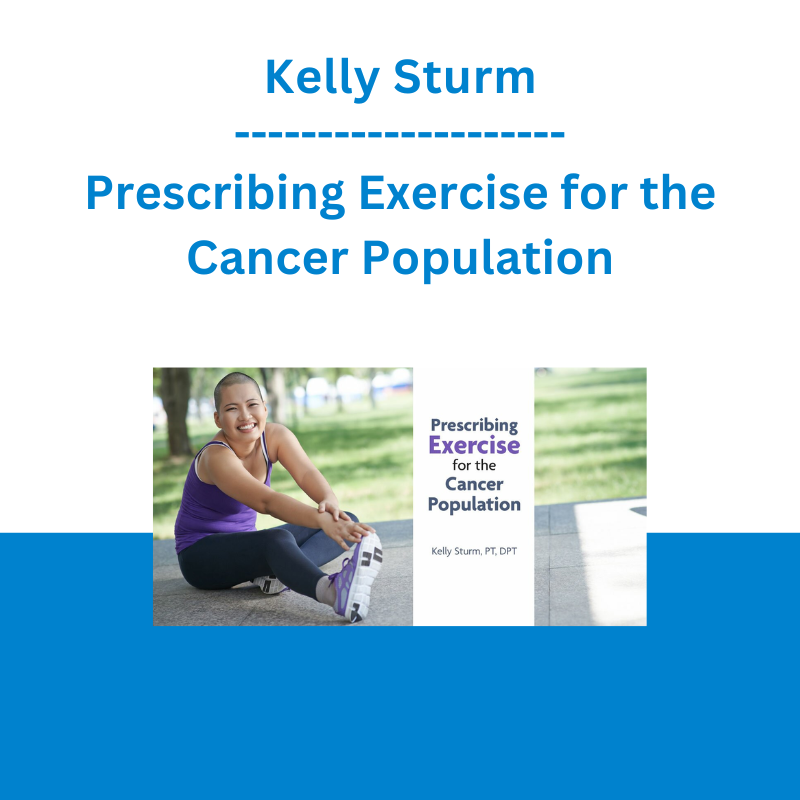*** Proof of Product ***
Exploring the Essential Features of “Kelly Sturm – Prescribing Exercise for the Cancer Population”
Speaker:Kelly Sturm, PT, DPT, OnCS, CLT-LANA
Duration:2 Hours 02 Minutes
Format:Audio and Video
Copyright:Feb 15, 2024
Media Type: Digital Seminar
Description
Over 18 million cancer survivors live in the United States, and 2 million new cases are diagnosed yearly. Along with new medical treatments, exercise is critical in managing cancer and treatment side effects. In this course, participants will explore the profound impact of physical activity on cancer prevention, treatment, survivorship, and palliative care. Many healthcare professionals may underestimate exercise’s importance in cancer care, failing to recommend or prescribe specific exercise programs as part of treatment strategies. This course aims to change this by educating clinicians and providers on evidence-based interventions and clinical applications of exercise, providing them with the tools to effectively integrate physical activity into their patients’ care plans. By bridging this knowledge gap, healthcare professionals can help their patients enhance treatment outcomes, reducing treatment-related side effects and enhancing overall quality of life before, during, and after cancer treatment.
Speaker
Kelly Sturm, PT, DPT, OnCS, CLT-LANA, is a physical therapist who received her B.S. in movement science from Winona State University and earned her Doctor of Physical Therapy (DPT) degree from the Mayo Clinic. She became a Certified Lymphedema Therapist (CLT) through Klose Training and is certified by the Lymphology Association of North America (LANA). In 2019, Kelly became one of the first board-certified oncology clinical specialists in the United States. She has taught in physical therapy programs and is a guest speaker at various conferences, programs, and community groups. Kelly has clinical expertise in the rehabilitation treatment of oncology diagnoses, primary and secondary lymphedema, and pelvic health. Kelly owns Cancer Rehab PT LLC, with engaging educational YouTube and Instagram platforms, bringing awareness and light to lymphedema, oncology rehabilitation, and physical therapy. After meeting many patients who lived in pain for years and assumed it was normal, she started creating content and sharing knowledge online to help those living with and beyond cancer and lymphedema learn how to manage and improve their symptoms. Her goal is to make education available to as many people as possible so more people would have the resources to realize that pain and discomfort are common, not normal, and feel empowered to start making small changes that lead to significant results.
Speaker Disclosures:
Financial: Kelly Sturm is the owner of Cancer Rehab PT, LLC. and has an employment relationship with Courage Kenny Rehabilitation Institute. She is a paid consultant for Airos Medical and is a clinical advisor with Vitala. Kelly receives a speaking honorarium and recording royalties from PESI, Inc. All relevant financial relationships with ineligible organizations have been mitigated.
Non-financial: Kelly Sturm has no relevant non-financial relationships.
Objectives
- Introduce oncology-related functional impairments and side effects that can be addressed in cancer rehabilitation
- Understand how exercise and physical activity affects individuals living with and beyond cancer
- Identify the current recommended exercise guidelines for cancer survivors
Outline
Introduction to Cancer and Effects
- Understand the incidence and prevalence
- Common side effects of cancer and cancer treatment
Cancer Rehabilitation and Exercise
- Define Cancer Rehabilitation
- Common impairments addressed in cancer rehab
- Unmet needs with patient reported impairments and side effects
- The Cancer Care Continuum – Where exercise plays a role
The Role of Exercise -Before Treatment (Prehab)
Define prehab
- Goals of exercise to address pre-existing impairments, improve physical health, and establish baseline
- The outcomes of supervised exercise in various cancer types (Garcia, 2016)(Singh, 2013)(van Rooijen, 2019)
- High-intensity interval training and affects of VO2peak in prehab setting (Palma, 2021)
- Exercise’s role in reducing surgical complications and recovery (Parker, 2019)
- Address the limitations of research and potential risks
The Role of Exercise -During Cancer Treatment
- Goals of exercise to address impairments, side effects and symptoms related to treatment
- Exercise impacting side effects during cancer treatment (Stout, 2017)
- Exercise benefits and risks during chemotherapy (Mijwel, 2018)
- Current exercise recommandations and prescriptions (Stout, 2017)
- Comparing outcomes of low-intensity vs mod/high-intensity exercise vs no exercise (van Waart, 2015)
- Acknowledge potential risks and contraindications of exercise during treatment
The Role of Exercise – After Cancer Treatment
- The goals of exercise after cancer treatment is completed
- Physical activity’s impact of non-physical outcomes (Fuller, 2018)
- Exercise role on risk of cancer mortality (Li, 2016)
- Limitations of the research and potential risks in the survivorship phase
The Role of Exercise – Long-Term Survivorship
- Discuss long-term clinical applications of exercise for cancer survivors
- Cardiovascular disease risk and exercise role (Henry, 2018)
- The role of exercise in androgen deprivation therapy (Newton, 2020)
- Pediatric cancer survivorship and exercise role in chronic diseases (Brunet, 2018)
- Cancer recurrence – does exercise lower the risk? (Morishita, 2020)
The Role of Exercise – Hospice/End of Life
- Recognize the benefits of exercise in end-of-life care settings (Chen, 2020)
- Adapting exercise to the needs of terminally ill cancer patients (Dittus, 2017)
- Understand the limitations and potential risks in palliative exercise programs
Interdisciplinary Collaboration
- Explore how healthcare professionals can work together to promote exercise in cancer care
- Discuss strategies for overcoming barriers to interdisciplinary collaboration
Course Conclusion and Future Directions
- Summarize key takeaways from the course
- Reflect on the evolving landscape of exercise in cancer care
- Encourage continued learning and research in the field
Note: Throughout the course, we will emphasize the limitations of existing research and the potential risks associated with exercise interventions, ensuring a comprehensive and responsible approach to exercise across the cancer continuum
Target Audience
- Massage Therapists (including Neuromuscular and Medical Massage Therapists)
- Physical Therapists
- Physical Therapist Assistants
- Occupational Therapists
- Occupational Therapy Assistants
- Exercise Physiologists
- Athletic Trainers
- Certified Strength and Conditioning Specialists
Please see the full list of alternative group-buy courses available here: https://lunacourse.com/shop/










 Matthew Kratter - Trader University
Matthew Kratter - Trader University  Erik Banks - Alternative Risk Transfer
Erik Banks - Alternative Risk Transfer  SMB - Options Training
SMB - Options Training  Jaden Phoenix - Consciousness Magic Study Group
Jaden Phoenix - Consciousness Magic Study Group  Akil Stokes & Jason Graystone - TierOneTrading - Trading Edge 2019
Akil Stokes & Jason Graystone - TierOneTrading - Trading Edge 2019  Jesse Livermore Trading System - Joe Marwood
Jesse Livermore Trading System - Joe Marwood  Dave Landry - Stock Selection Course
Dave Landry - Stock Selection Course  Simpler Trading - Bruce Marshall - The Options Defense Course
Simpler Trading - Bruce Marshall - The Options Defense Course  Ed Ponsi - Forex Trading
Ed Ponsi - Forex Trading  Racing Workshop - Complete Online Package
Racing Workshop - Complete Online Package  Team NFT Money - Ultimate NFT Playbook
Team NFT Money - Ultimate NFT Playbook  Greg Loehr - Advanced Option Trading With Broken Wing Butterflies
Greg Loehr - Advanced Option Trading With Broken Wing Butterflies  George Fontanills & Tom Gentile - Optionetics Wealth Without Worry Course
George Fontanills & Tom Gentile - Optionetics Wealth Without Worry Course